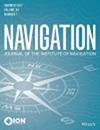RFI Mapped by Spaceborne GNSS-R Data
IF 2
3区 地球科学
Q1 ENGINEERING, AEROSPACE
引用次数: 0
Abstract
Radio frequency interference (RFI) in global navigation satellite system (GNSS) frequencies can endanger human life and safety by preventing the use of these signals for navigation and positioning, in addition to degrading measurements for science applications. Here, we use data from the Cyclone GNSS (CYGNSS) constellation to map GNSS RFI from 2017 to 2022, identify the location of several potential sources of RFI, and quantify the duration of transmission. Although our method of RFI detection can only provide a rough approximation of transmitter positions, it is possible that advanced data processing techniques could better pinpoint their locations, once guided by these observations. We find that, since the launch of CYGNSS, GNSS jammers have proliferated across the world and are often associated with the beginnings of geopolitical unrest. Our results agree well with previous studies that have also used satellite observations to map ground-based RFI transmission.星载GNSS-R数据映射的RFI
全球导航卫星系统(GNSS)频率的射频干扰(RFI)会阻碍这些信号用于导航和定位,从而危及人类的生命和安全,此外还会降低科学应用的测量精度。在这里,我们使用来自Cyclone GNSS (CYGNSS)星座的数据来绘制2017年至2022年的GNSS RFI地图,确定几个潜在RFI源的位置,并量化传输的持续时间。虽然我们的RFI检测方法只能提供发射机位置的粗略近似值,但有可能先进的数据处理技术可以更好地确定它们的位置,一旦由这些观察指导。我们发现,自CYGNSS启动以来,GNSS干扰机在全球范围内激增,通常与地缘政治动荡的开始有关。我们的研究结果与之前的研究一致,这些研究也使用卫星观测来绘制基于地面的RFI传输。
本文章由计算机程序翻译,如有差异,请以英文原文为准。
求助全文
约1分钟内获得全文
求助全文
来源期刊

Navigation-Journal of the Institute of Navigation
ENGINEERING, AEROSPACE-REMOTE SENSING
CiteScore
5.60
自引率
13.60%
发文量
31
期刊介绍:
NAVIGATION is a quarterly journal published by The Institute of Navigation. The journal publishes original, peer-reviewed articles on all areas related to the science, engineering and art of Positioning, Navigation and Timing (PNT) covering land (including indoor use), sea, air and space applications. PNT technologies of interest encompass navigation satellite systems (both global and regional), inertial navigation, electro-optical systems including LiDAR and imaging sensors, and radio-frequency ranging and timing systems, including those using signals of opportunity from communication systems and other non-traditional PNT sources. Articles about PNT algorithms and methods, such as for error characterization and mitigation, integrity analysis, PNT signal processing and multi-sensor integration, are welcome. The journal also accepts articles on non-traditional applications of PNT systems, including remote sensing of the Earth’s surface or atmosphere, as well as selected historical and survey articles.
 求助内容:
求助内容: 应助结果提醒方式:
应助结果提醒方式:


